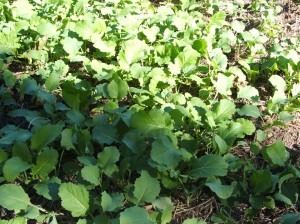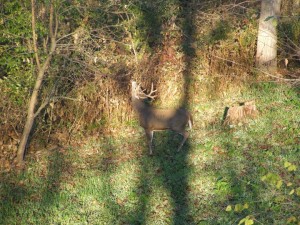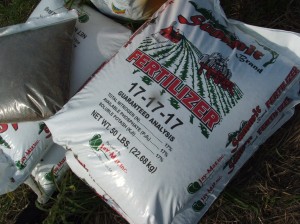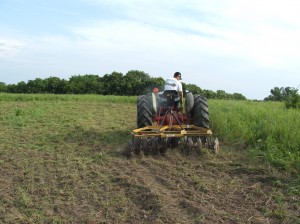Fall Food Plots Broken Down
It is no secret that my favorite fall food plot to hunt over is a stand of mature soybeans. However, soybeans are such a preferred food source that it is not uncommon for a bean plot to be completely consumed before seasons end. So, to alleviate the potential problem of completely consumed soybeans, each season I plant green food plots to complement my bean plots.
Part I Summer Planted Brassicas
Around mid-July to early August I like to plant brassicas. When I plant brassicas, I like to plant blends. A blend that contains a forage variety, a rape variety, and a non-forage turnip. The forage brassica provides the plot with a plant that focuses its growth into leaf production creating a lot of forage. Rape provides a highly digestible leafy plant; many varieties are very cold tolerant meaning you can have a green plot into and through winter. Non-forage turnips concentrate their growth into the root. In the later stages of the hunting season and throughout winter deer will dig and paw to get at these roots making them a good late season attractant.

These brassicas are only a couple weeks old. With some rain and sun they will grow profusely into fall. When planted early, they will provide maximum tonnage and roots or bulbs that are consumed in late fall and winter. When planted later in early fall, they will provide a green frost tolerant food source.
Now…I personally don’t like brassicas as an early fall food plot because I believe food plot attractiveness is relative to what is available. But I plant these brassica blends to make sure I have a late season plot to hunt over; and, these plots almost always last into spring making them great shed hunting plots. I plant them in mid-July and early August so that the roots or bulbs on the brassicas can grow big providing the late season food source. When my soybeans have been completely consumed and alfalfa has seen many days of hard frosts, brassicas start to kick in and take over as the preferred source of food. If you hunt in areas with no beans, alfalfa, corn, or bait piles for that matter, brassicas can be a preferred source of food even in early fall.
Part II Fall Planted Annual Greens
At the end of August or very early parts of September here in the Midwest, I finish my fall green plots. These plots are the small plots planted in transition areas leading to bigger exterior plots. They can be logging trails, inside corners or parts of bigger Ag fields that are not planted or missed by the big Ag equipment. But, they are also the plantings of choice for all my interior food plots.

This is a buck I nicknamed “Salad Bar” a few years back. He frequented an interior plot where I took this picture on a morning hunt in October. Deer and bucks of all age classes cannot help themselves when it comes to visiting an interior plot like this one. I planted this plot around September 1st. with a blend of winter rye and brassicas. The greens are completely mowed off by the deer.
When I plant an interior food plot I know that the deer will visit these plots a lot; deer will be in them at all times of the day. So, these plots need to withstand a lot of grazing. My choice is a blend of winter rye, dwarf essex rape, a forage turnip like Barkant or Appin, and sometimes a faster growing clover like Berseem or white clover. Winter rye will remain green and palatable even after very heavy killing frosts. Rape is very frost tolerant, is quick growing, and provides a lot of forage. Forage turnips provide large amounts of forage for these small plots. White clover will keep the plot green over winter and many times into the next year. Berseem clover is very fast growing but is not winter hardy. The attractiveness with these plots (especially my interior plots) is the location itself. I have used other green forages like oats, peas, soybeans, etc. in these plots. The key here is getting something to come up green that will withstand heavy grazing and frost.
Update: 8/22/2017 For my fall blend I no longer use Barkant turnips. My favorite turnip for these planting has become Appin turnips so I stick with these exclusively. I also no longer use Berseem clover. If I do want to mix in clover to establish a clover plot, I’ll use a blend of white clovers and medium red clover. Bottom line, winter rye is the essential ingredient in this blend, the Appin turnips are quite attractive so I usually add those in followed by some rape. I’ll only add the clover if I’m trying to establish a perennial plot of clover.
Part III Planting Methods
I don’t get all bent out of shape worrying about fertilizer and ph perfection with any of these green plots. I typically sow the seed at a rate of about 5-10 pounds per acre for the small seed varieties (clover, rape, brassica) and about 1 bushel per acre for the rye or oats mixed with the other seed varieties. Fertilizer requirements can vary a bit, but what I generally do is fertilize at a rate of two or three fifty pound bags of triple 19 (19,19,19) per acre and I’ve had great results.

A good fertilizer for brassicas would be triple 17. Put on 2-4 bags per acre. You can see here in this picture my non name brand bag of brassica seed!!!
Planting is pretty easy and straightforward…I disc up the ground until I see a lot of dirt, the sod is busted up, weeds are tilled in, etc. Then I broadcast the seed and fertilizer over the seed bed using a hand held seeder, atv seeder, or by hand, and then drag the seed in using a tooth drag (bed spring, pallet, or section of fence will work too).

Planting brassicas begin with busting up the ground. Here, Anthony is breaking the ground by making a few passes with a disc. Spread the fertilizer and seed and drag in or disc very lightly.
In Closing
I recently got a multimedia text message from a good friend of mine. It was a picture of a “new” food plot idea or gimmick as I call them. My friend’s text was short and to the point….”The s**t they come up with”. His text message was inspiration for this article.
It is almost impossible to sort through all the marketing when it comes to food plots. Repackaging and selling forage seed varieties have become big business. But, these seed varieties have been around for decades planted by farmers for grazing their animals. Contrary to what you may have heard, read, or watched on TV, these seed varieties repackaged in fancy bags and marketed to the hilt are the same seeds that farmers have been planting for a long time. There is only one difference, the price! I don’t buy marketed food plot seed and you shouldn’t either. You can pay as much as 5 times for name brand seed over the exact same farm seed. Don’t be sold on hype!
Just remember, seed is seed. I don’t endorse any seed company. But many times hunters just don’t know where to go to get food plot seed at good prices. So…I’ll list one company that sells seed bulk at very good prices. If you look further I’m sure you can find more. The company is Welter Seed and Honey Company or welterseed.com. They also have a lot of good information about their seed varieties right on their web site. Take a look at them and save big bucks!
For more information on fall food plots, click HERE. This is another article that I wrote for Iowa Sportsman Magazine.
